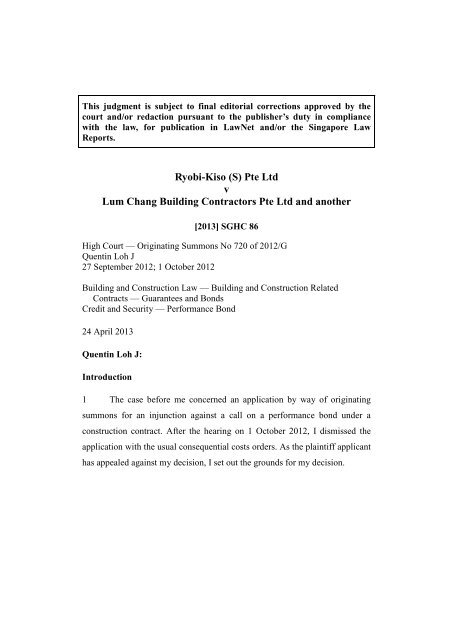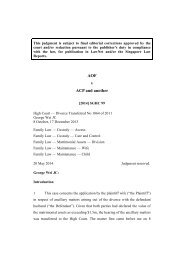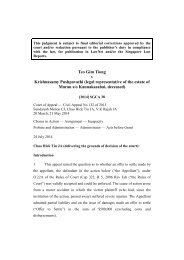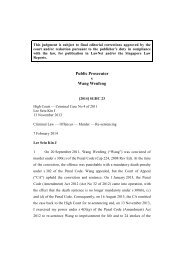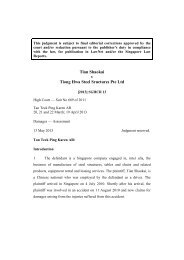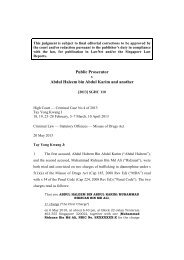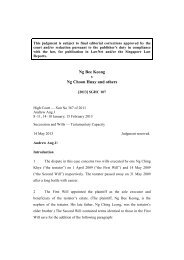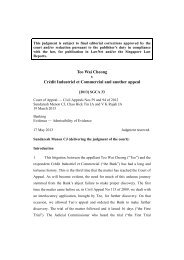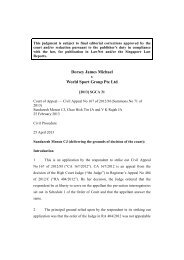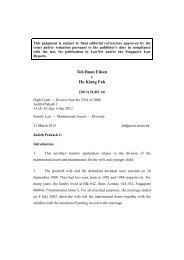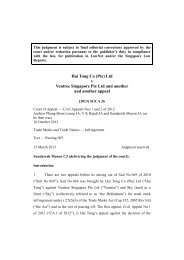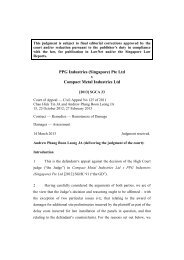Ryobi-Kiso (S) Pte Ltd v Lum Chang Building Contractors Pte Ltd and another
Ryobi-Kiso (S) Pte Ltd v Lum Chang Building Contractors Pte Ltd and another
Ryobi-Kiso (S) Pte Ltd v Lum Chang Building Contractors Pte Ltd and another
You also want an ePaper? Increase the reach of your titles
YUMPU automatically turns print PDFs into web optimized ePapers that Google loves.
This judgment is subject to final editorial corrections approved by the<br />
court <strong>and</strong>/or redaction pursuant to the publisher’s duty in compliance<br />
with the law, for publication in LawNet <strong>and</strong>/or the Singapore Law<br />
Reports.<br />
<strong>Ryobi</strong>-<strong>Kiso</strong> (S) <strong>Pte</strong> <strong>Ltd</strong><br />
v<br />
<strong>Lum</strong> <strong>Chang</strong> <strong>Building</strong> <strong>Contractors</strong> <strong>Pte</strong> <strong>Ltd</strong> <strong>and</strong> <strong>another</strong><br />
[2013] SGHC 86<br />
High Court — Originating Summons No 720 of 2012/G<br />
Quentin Loh J<br />
27 September 2012; 1 October 2012<br />
<strong>Building</strong> <strong>and</strong> Construction Law — <strong>Building</strong> <strong>and</strong> Construction Related<br />
Contracts — Guarantees <strong>and</strong> Bonds<br />
Credit <strong>and</strong> Security — Performance Bond<br />
24 April 2013<br />
Quentin Loh J:<br />
Introduction<br />
1 The case before me concerned an application by way of originating<br />
summons for an injunction against a call on a performance bond under a<br />
construction contract. After the hearing on 1 October 2012, I dismissed the<br />
application with the usual consequential costs orders. As the plaintiff applicant<br />
has appealed against my decision, I set out the grounds for my decision.
<strong>Ryobi</strong>-<strong>Kiso</strong> (S) <strong>Pte</strong> <strong>Ltd</strong> v <strong>Lum</strong> <strong>Chang</strong> <strong>Building</strong> <strong>Contractors</strong><br />
<strong>Pte</strong> <strong>Ltd</strong> [2013] SGHC 86<br />
Facts<br />
The parties<br />
2 The plaintiff is a piling specialist (“the Plaintiff”) while the first<br />
defendant is a civil <strong>and</strong> building contractor (“the 1 st Defendant”). The second<br />
defendant is an insurance company (“the 2 nd Defendant”) which issued the<br />
performance bond that is the subject of this application.<br />
3 The 1 st Defendant is the main contractor for Contract 912 viz the<br />
“Design <strong>and</strong> Construction of Station at Bukit Panjang <strong>and</strong> Tunnels for<br />
Downtown Line Stage 2 at Woodl<strong>and</strong>s Road <strong>and</strong> Upper Bukit Timah”. The<br />
employer of the 1 st Defendant for Contract 912 is the L<strong>and</strong> Transport<br />
Authority (“LTA”), pursuant to a contract dated 17 June 2009 which the latter<br />
entered into with the 1 st Defendant (“the Main Contract”).<br />
4 The Plaintiff was engaged by the 1 st Defendant under a sub-contract<br />
dated 11 February 2010 (“the Sub-Contract”). The Sub-Contract was for part<br />
of the works under the Main Contract.<br />
The Performance Bond under the Sub-Contract<br />
5 Pursuant to cl 3(a) of the Sub-Contract, 1 the Plaintiff provided the 1 st<br />
Defendant with an unconditional performance bond in the sum of $1.88m<br />
which was issued by the 2 nd Defendant on 1 June 2010 (“the Performance<br />
1 Thung Chun Heng 1 st Affidavit at p 24.<br />
2
<strong>Ryobi</strong>-<strong>Kiso</strong> (S) <strong>Pte</strong> <strong>Ltd</strong> v <strong>Lum</strong> <strong>Chang</strong> <strong>Building</strong> <strong>Contractors</strong><br />
<strong>Pte</strong> <strong>Ltd</strong> [2013] SGHC 86<br />
Bond”). The Performance Bond was 10% of the Sub-Contract price of<br />
$18.8m.<br />
The Sub-Contract Works<br />
Donuts & Peanuts <strong>and</strong> Zone 2 Station Box<br />
6 The scope of the works covered by the Sub-Contract is detailed in cl 1<br />
of Part 1 of the Schedule in the Sub-Contract: 2<br />
The Sub-Contract Works to be executed by the Sub-<br />
Contractor shall be the Construction <strong>and</strong> Completion of<br />
Foundation, Kingposts/Deckposts, Secant <strong>and</strong> Contiguous<br />
Bored Piles for Station Box (known as “Zone 2”) <strong>and</strong> under<br />
BPLRT [Bukit Panjang Light Rail Transit] Viaduct (known as<br />
“Donuts & Peanuts”) to Downtown Line Stage 2 for Contract<br />
912 in compliance with the Sub-Contract <strong>and</strong> the Main<br />
Contract.<br />
In essence, the Sub-Contract scope of works shall be deemed<br />
to include, but not limited to, the following description of the<br />
major items:<br />
...<br />
The works therefore involved carrying out piling <strong>and</strong> associated works under<br />
the existing Bukit Panjang Light Rail <strong>and</strong> alongside or nearby busy road<br />
junctions <strong>and</strong> a station box for a future MRT line <strong>and</strong> station. The road<br />
junctions involved busy traffic intersections of Upper Bukit Timah,<br />
Woodl<strong>and</strong>s, Bukit Panjang <strong>and</strong> Choa Chu Kang Roads.<br />
7 I shall refer to the general scope of the Plaintiff’s works as “the Sub-<br />
Contract Works”. The two locations where the Sub-Contract Works were to be<br />
2 Thung Chun Heng 1 st Affidavit at p 49.<br />
3
<strong>Ryobi</strong>-<strong>Kiso</strong> (S) <strong>Pte</strong> <strong>Ltd</strong> v <strong>Lum</strong> <strong>Chang</strong> <strong>Building</strong> <strong>Contractors</strong><br />
<strong>Pte</strong> <strong>Ltd</strong> [2013] SGHC 86<br />
performed are described as Donut & Peanuts <strong>and</strong> Zone 2 Station Box. The<br />
completion times for the Sub-Contract Works are spelt out in Part 3 of the<br />
Schedule. 3 Work for Donuts & Peanuts was to be completed within 1 April<br />
2010 to 30 September 2010, while work for Zone 2 Station Box was to be<br />
completed within 1 March 2010 to 31 May 2011. Clause 5 of Part 3 of the<br />
Schedule sets out the liquidated damages for delay in completion of works for<br />
Donuts & Peanuts <strong>and</strong> Zone 2 Station Box.<br />
8 According to the 1 st Defendant, the works for Donuts & Peanuts <strong>and</strong><br />
Zone 2 Station Box exceeded the maximum time stipulated for completion by<br />
152 days <strong>and</strong> 332 days respectively. 4 If the Plaintiff is liable for the total<br />
number of days which exceeded the relevant completion dates, its total<br />
liability would be $7.26m. The 1 st Defendant’s Project Director filed an<br />
affidavit setting out the delays caused by the Plaintiffs. 5 These include delays<br />
in submitting Method Statements <strong>and</strong> drawings (which were required before<br />
approvals could be obtained from the various authorities for works to be<br />
carried out), poor planning <strong>and</strong> mobilisation, 3-months delay in the foregoing<br />
for the LTA Development & <strong>Building</strong> Control Division clearance for works<br />
under the Bukit Panjang Light Rail viaduct, using less powerful <strong>and</strong> slower<br />
low-headroom piling equipment where there were no headroom restrictions.<br />
Of course, the Plaintiff denied liability for the late completion. 6<br />
3 Thung Chun Heng 1 st Affidavit at p 53.<br />
4 Rintu Chakravarthy 1 st Affidavit at paras 29–30.<br />
5 Rintu Chakravarthy 1 st Affidavit at paras 9–30 <strong>and</strong> 32–37.<br />
6 Thung Chun Heng 2 nd Affidavit at pp 10–12.<br />
4
<strong>Ryobi</strong>-<strong>Kiso</strong> (S) <strong>Pte</strong> <strong>Ltd</strong> v <strong>Lum</strong> <strong>Chang</strong> <strong>Building</strong> <strong>Contractors</strong><br />
<strong>Pte</strong> <strong>Ltd</strong> [2013] SGHC 86<br />
Termination of the Sub-Contract <strong>and</strong> Stage 4 Works<br />
9 In or about May 2012, the 1 st Defendant’s project manager, Mr K S<br />
Rao (“Mr Rao”), called the Plaintiff twice, asking them to submit a<br />
programme for the next phase of the Sub-Contract Works (“the Stage 4<br />
Works”). 7 Under cl 22(a) of the Sub-Contract, 8 the Plaintiff was obliged to<br />
provide information, or programmes, of the arrangements <strong>and</strong> sequence which<br />
it proposed to adopt for the execution of the Sub-Contract Works. It should be<br />
noted that the 1 st Defendant had already previously asked the Plaintiff for such<br />
a programme, for instance, by a letter dated 12 April 2012. 9 The Plaintiff’s<br />
reply then was that pursuant to a letter by the 1 st Defendant dated 12 July 2011<br />
(“the 12 July 2011 Letter”), the Stage 4 Works had been deleted from the Sub-<br />
Contract Works. 10 A series of correspondence then followed in April in which<br />
the 1 st Defendant insisted that there was no deletion <strong>and</strong> the Plaintiff insisted<br />
the converse. 11 However, at the time of Mr Rao’s telephone calls, the Plaintiff<br />
stood by its position that it was not carrying out the Stage 4 Works as those<br />
works had been deleted from the Sub-Contract Works unless they were treated<br />
as a variation for which additional payment would be required (see [11]<br />
below).<br />
7 Rintu Chakravarthy 1 st Affidavit at para 42.<br />
8 Thung Chun Heng 1 st Affidavit at p 41.<br />
9 Rintu Chakravarthy 1 st Affidavit at p 83.<br />
10 Rintu Chakravarthy 1 st Affidavit at p 84.<br />
11 Rintu Chakravarthy 1 st Affidavit at pp 85–89.<br />
5
<strong>Ryobi</strong>-<strong>Kiso</strong> (S) <strong>Pte</strong> <strong>Ltd</strong> v <strong>Lum</strong> <strong>Chang</strong> <strong>Building</strong> <strong>Contractors</strong><br />
<strong>Pte</strong> <strong>Ltd</strong> [2013] SGHC 86<br />
10 I digress for the moment to explain the significance of the 12 July 2011<br />
Letter. That letter was sent by the 1 st Defendant to remind the Plaintiff to<br />
complete certain piles by 30 September 2011. This was just <strong>another</strong> letter in a<br />
series of letters from the 1 st Defendant to the Plaintiff recording the poor<br />
performance of the Plaintiff which was causing delays. The 12 July 2011<br />
Letter ended with: 12<br />
Lastly, please note that in order to reduce your load, we have<br />
piles in front of Ten Mile Junction be carried out (sic) by Zap<br />
Piling behalf (sic) of <strong>Ryobi</strong> <strong>Kiso</strong> to avoid further delay to the<br />
piling works <strong>and</strong> subsequent activity. ...<br />
[emphasis added]<br />
The Plaintiff treated the 1 st Defendant’s employment of Zap Piling <strong>Pte</strong> <strong>Ltd</strong><br />
(“ZPPL”) pursuant to the 12 July 2011 Letter to do part of the Sub-Contract<br />
Works as a breach of contract. 13 Nevertheless, the Plaintiff <strong>and</strong> ZPPL<br />
continued to carry out their respective parts of the Sub-Contract Works.<br />
11 However, some 10 months later, when it came to the Stage 4 Works<br />
(which were part of the Sub-contract Works), the Plaintiff told the 1 st<br />
Defendant that the scope of the Sub-Contract Works had been varied as a<br />
result of the 1 st Defendant’s employment of ZPPL such that the Stage 4 Works<br />
would be considered a variation for which additional payment was required. 14<br />
The Plaintiff forwarded to the 1 st Defendant its proposed quote <strong>and</strong> schedule<br />
of the programme for the Stage 4 Works on 4 June 2012 which showed that<br />
12 Thung Chun Heng 1 st Affidavit at p 187.<br />
13 Thung Chun Heng 1 st Affidavit at para 36.<br />
14 Thung Chun Heng 1 st Affidavit at para 46.<br />
6
<strong>Ryobi</strong>-<strong>Kiso</strong> (S) <strong>Pte</strong> <strong>Ltd</strong> v <strong>Lum</strong> <strong>Chang</strong> <strong>Building</strong> <strong>Contractors</strong><br />
<strong>Pte</strong> <strong>Ltd</strong> [2013] SGHC 86<br />
the works would extend to mid-August 2012. On the same day, the 1 st<br />
Defendant terminated the Sub-Contract with the Plaintiff. The Plaintiff<br />
commenced the first adjudication application on 7 June 2012 for security of<br />
payments of $5.37m as the total sum of Progress Payment No 27 under the<br />
Sub-Contract (“AA SOP 52”). The Plaintiff commenced a second adjudication<br />
application for <strong>another</strong> $4.52m in relation to payments for <strong>another</strong> subcontract<br />
relating to the construction of diaphragm walls (“AA SOP 53”). I shall refer to<br />
AA SOP 52 <strong>and</strong> AA SOP 53 collectively as “the Adjudications”.<br />
12 The 1 st Defendants point out that they were initially forced to take<br />
some work out of the Plaintiff’s h<strong>and</strong>s <strong>and</strong> engage ZPPL as the Plaintiff was<br />
seriously delayed in the performance of their obligations. When it came to the<br />
Stage 4 Works, it was due to commence on the 11 June 2012. There was a<br />
planned major road diversion, arranged with the various authorities, from 10<br />
June 2012 which involved the busy Upper Bukit Timah, Woodl<strong>and</strong>s, Bukit<br />
Panjang <strong>and</strong> Choa Chu Kang road junction. It appears that these works around<br />
this diversion had to be completed by July 2012. Yet, at this crucial point in<br />
time, according to the 1 st Defendant’s case, the Plaintiff held them to ransom<br />
by making a claim that the Stage 4 Works was a variation <strong>and</strong> which they said<br />
would extend into mid-August 2012.<br />
13 As a result of the above circumstances, the 1 st Defendant engaged<br />
ZPPL to do the Stage 4 Works. The contract with ZPPL was formally entered<br />
into on 24 July 2012 at a cost of $1.27m. 15 This was an additional $0.64m<br />
more than what the 1 st Defendant would have had to pay the Plaintiff had the<br />
15 Rintu Chakravarthy 1 st Affidavit at p 167.<br />
7
<strong>Ryobi</strong>-<strong>Kiso</strong> (S) <strong>Pte</strong> <strong>Ltd</strong> v <strong>Lum</strong> <strong>Chang</strong> <strong>Building</strong> <strong>Contractors</strong><br />
<strong>Pte</strong> <strong>Ltd</strong> [2013] SGHC 86<br />
latter performed the Stage 4 Works. 16 ZPPL appears to have completed the<br />
Stage 4 Works by 29 July 2012. 17<br />
Present proceedings – Originating Summons No 720 of 2012/G<br />
14 On 13 July 2012, the 1 st Defendant called on the Performance Bond<br />
(“the Call”) on the grounds of the Plaintiff’s breaches of the Sub-Contract. 18<br />
The Plaintiff then commenced these proceedings to restrain the 1 st Defendant<br />
from receiving the proceeds of the Call.<br />
15 On 27 July 2012, the Plaintiff commenced the present proceedings<br />
seeking, inter alia, a declaration that the 1 st Defendant be restrained from<br />
receiving payment under the Call, <strong>and</strong> that the 2 nd Defendant be restrained<br />
from making payment pursuant to the Call. I should just add that the<br />
substantive dispute(s) between the parties is subject to an ongoing arbitration<br />
which was commenced on 27 September 2012. When I dismissed the<br />
application, I did say to counsel that the substantive dispute(s) in this matter<br />
has to be resolved by arbitration.<br />
Parties’ respective cases<br />
Plaintiff’s case<br />
16 The Plaintiff contended that the Call was unconscionable as there was<br />
a genuine dispute as to whether the 1 st Defendant had breached the Sub-<br />
16 Rintu Chakravarthy 1 st Affidavit at p 176.<br />
17 Rintu Chakravarthy 1 st Affidavit at p 50.<br />
18 Rintu Chakravarthy 1 st Affidavit at para 5.<br />
8
<strong>Ryobi</strong>-<strong>Kiso</strong> (S) <strong>Pte</strong> <strong>Ltd</strong> v <strong>Lum</strong> <strong>Chang</strong> <strong>Building</strong> <strong>Contractors</strong><br />
<strong>Pte</strong> <strong>Ltd</strong> [2013] SGHC 86<br />
Contract either by removing part of the works under the Sub-Contract Works<br />
to be performed by ZPPL, or by terminating the Sub-Contract altogether. The<br />
Call, in the Plaintiff’s view, was not in good faith, clearly oppressive, <strong>and</strong><br />
should be construed as a bullying tactic. Even though the Plaintiff insisted that<br />
it did not know the reason why the 1 st Defendant issued the Call, 19 it<br />
speculated that the Call appears to be vindictive. The Plaintiff pointed to the<br />
decisions from the Adjudications on 10 <strong>and</strong> 12 July 2012 in which the 1 st<br />
Defendant was ordered to pay the Plaintiff $1.86m as a possible trigger for the<br />
Call which happened on 13 July 2012, the day after the second adjudication<br />
decision.<br />
1 st Defendant’s case<br />
17 The 1 st Defendant agreed that unconscionability is a ground upon<br />
which the court can grant an injunction restraining the beneficiary of a<br />
performance bond from calling on the bond. 20 However, it denied that it had<br />
acted unconscionably. The 1 st Defendant claimed that the Plaintiff’s<br />
allegations of, inter alia, bad faith, oppression, bullying, are speculative, bare<br />
<strong>and</strong> unsupported by evidence. On the 1 st Defendant’s part, they have exhibited<br />
evidence in relation to the Plaintiff’s delays <strong>and</strong> breaches. The 1 st Defendant’s<br />
case was that it did not breach the Sub-Contract by engaging ZPPL or by<br />
terminating the Sub-Contract. It pointed to the 12 July 2011 Letter where it<br />
was said that ZPPL would do the works on the Plaintiff’s behalf. As for<br />
termination, the 1 st Defendant contended that it did so because the Plaintiff<br />
19 Thung Chun Heng 1 st Affidavit at para 58.<br />
20 1 st Defendant’s submissions at para 5.<br />
9
<strong>Ryobi</strong>-<strong>Kiso</strong> (S) <strong>Pte</strong> <strong>Ltd</strong> v <strong>Lum</strong> <strong>Chang</strong> <strong>Building</strong> <strong>Contractors</strong><br />
<strong>Pte</strong> <strong>Ltd</strong> [2013] SGHC 86<br />
refused to carry out the Stage 4 Works. At the same time, the 1 st Defendant<br />
also pointed out that it had genuine claims against the Plaintiff in liquidated<br />
damages for late completion, the extra costs incurred by having to engage<br />
ZPPL, <strong>and</strong> overpayments made to the Plaintiff. 21 In these circumstances, the<br />
1 st Defendant was merely protecting its own interest by calling on the<br />
Performance Bond, 22 an act which was done bona fide.<br />
Grounds for my decision<br />
The relevant legal principles<br />
18 Whatever label the Plaintiff attached to the 1 st Defendant’s conduct in<br />
making the Call, it is clear that the Plaintiff’s case is founded on<br />
unconscionability. The concept of unconscionability in the context of<br />
restraining calls on performance bonds, as accepted in Singapore by the Court<br />
of Appeal in Dauphin Offshore Engineering & Trading <strong>Pte</strong> <strong>Ltd</strong> v The Private<br />
Office of HRH Sheikh Sultan bin Khalifa bin Zayed Al Nahyan [2000] 1<br />
SLR(R) 117 (“Dauphin Offshore”) at [45], involves:<br />
... unfairness, as distinct from dishonesty or fraud, or conduct<br />
of a kind so reprehensible or lacking in good faith that a court<br />
of conscience would either restrain the party or refuse to<br />
assist the party. Mere breaches of contract by the party in<br />
question ... would not by themselves be unconscionable. ...<br />
[emphasis in original]<br />
21 1 st Defendant’s submissions at para 19.<br />
22 1 st Defendant’s submissions at para 23.<br />
10
<strong>Ryobi</strong>-<strong>Kiso</strong> (S) <strong>Pte</strong> <strong>Ltd</strong> v <strong>Lum</strong> <strong>Chang</strong> <strong>Building</strong> <strong>Contractors</strong><br />
<strong>Pte</strong> <strong>Ltd</strong> [2013] SGHC 86<br />
19 Instances of when it would be considered unconscionable to call on a<br />
performance bond were helpfully summarised by the Court of Appeal in<br />
Dauphin Offshore (at [46]):<br />
... (a) in Kvaerner Singapore <strong>Pte</strong> <strong>Ltd</strong> v UDL Shipbuilding<br />
(Singapore) <strong>Pte</strong> <strong>Ltd</strong> ... the beneficiary made a call based on a<br />
breach induced by their own default <strong>and</strong> was not permitted to<br />
do so; (b) in Royal Design Studio <strong>Pte</strong> <strong>Ltd</strong> v <strong>Chang</strong> Development<br />
<strong>Pte</strong> <strong>Ltd</strong> ... an injunction was granted where the beneficiary's<br />
call on the bond was based on delays in construction that<br />
were caused by the beneficiary's own default in failing to make<br />
timely payments on the interim certificates issued by the<br />
architect <strong>and</strong> a considerable sum due to the account party<br />
under the joint venture agreement was retained by the<br />
beneficiary; (c) in Min Thai Holdings <strong>Pte</strong> <strong>Ltd</strong> v Sunlabel <strong>Pte</strong><br />
<strong>Ltd</strong> ... the defendant-buyer was restrained from calling on the<br />
performance guarantee when the non-delivery of rice was due<br />
to floods caused by typhoon <strong>and</strong> there was a “force majeure”<br />
clause in the contract, as the court felt that it was<br />
unconscionable, in the circumstances, for the defendantbuyer<br />
to receive payment under the performance guarantee.<br />
In the cases cited above where the call of the bond was considered<br />
unconscionable, either the beneficiary of the performance bond had by its own<br />
default contributed to the circumstances which founded the call, or both<br />
parties were wholly innocent. Evidently, it takes more than a mere default (ie<br />
mere breaches of contract) by the beneficiary to sustain an argument on<br />
unconscionability. In this regard, I note the high <strong>and</strong> strict st<strong>and</strong>ard of proof<br />
required of the applicant seeking the injunction which has been consistently<br />
applied by the Court of Appeal (Anwar Siraj <strong>and</strong> <strong>another</strong> v Teo Hee Lai<br />
<strong>Building</strong> Construction <strong>Pte</strong> <strong>Ltd</strong> [2003] 1 SLR(R) 394 at [11] citing Dauphin<br />
Offshore at [57]):<br />
... In Bocotra ... this court stated that “a high degree of<br />
strictness applies, as the applicant will be required to establish<br />
a clear case of fraud or unconscionability in the interlocutory<br />
proceedings. It is clear that mere allegations are insufficient”.<br />
11
<strong>Ryobi</strong>-<strong>Kiso</strong> (S) <strong>Pte</strong> <strong>Ltd</strong> v <strong>Lum</strong> <strong>Chang</strong> <strong>Building</strong> <strong>Contractors</strong><br />
<strong>Pte</strong> <strong>Ltd</strong> [2013] SGHC 86<br />
... In our opinion, what must be shown is a strong prima facie<br />
case of unconscionability. ...<br />
[emphasis in original omitted; emphasis added]<br />
20 That said, I am cognisant of the severity of calls on performance<br />
bonds, <strong>and</strong> how the court must be mindful of abuse. In GHL <strong>Pte</strong> <strong>Ltd</strong> v<br />
Unitrack <strong>Building</strong> Construction <strong>Pte</strong> <strong>Ltd</strong> <strong>and</strong> <strong>another</strong> [1999] 3 SLR(R) 44, the<br />
Court of Appeal said (at [24]):<br />
We agree that performance bonds are used frequently in the<br />
construction industry; that they are provided by <strong>and</strong> to parties<br />
who deal at arm's length; that the use of performance bonds<br />
has resulted in substantial benefits to the parties <strong>and</strong> also in<br />
savings; that the courts should give effect to the intention of<br />
the parties; <strong>and</strong> that the law in relation to performance bonds<br />
should be placed on “a clear <strong>and</strong> unambiguous footing” so<br />
that they could be accepted by parties whether in Singapore or<br />
abroad. But, with respect, these are not the points involved<br />
with which we are concerned. We are concerned with<br />
abusive calls on the performance bonds. It should not be<br />
forgotten that a performance bond can operate as an oppressive<br />
instrument, <strong>and</strong> in the event that a beneficiary calls on the bond<br />
in circumstances, where there is prima facie evidence of fraud<br />
or unconscionability, the court should step in to intervene at the<br />
interlocutory stage until the whole of the circumstances of the<br />
case has been investigated. It should also not be forgotten that<br />
a performance bond is basically a security for the performance<br />
of the main contract, <strong>and</strong> as such we see no reason, in<br />
principle, why it should be so sacrosanct <strong>and</strong> inviolate as not<br />
to be subject to the court's intervention except on the ground<br />
of fraud. We agree that a beneficiary under a performance<br />
bond should be protected as to the integrity of the security he<br />
has in case of non-performance by the party on whose<br />
account the performance bond was issued, but a temporary<br />
restraining order does not prejudice or adversely affect the<br />
security; it merely postpones the realisation of the security<br />
until the party concerned is given an opportunity to prove his<br />
case ...<br />
[emphasis added]<br />
21 Ultimately, the juridical basis for an injunction to restrain a<br />
performance bond on the ground of unconscionability lies in equity. The key<br />
12
<strong>Ryobi</strong>-<strong>Kiso</strong> (S) <strong>Pte</strong> <strong>Ltd</strong> v <strong>Lum</strong> <strong>Chang</strong> <strong>Building</strong> <strong>Contractors</strong><br />
<strong>Pte</strong> <strong>Ltd</strong> [2013] SGHC 86<br />
consideration in ascertaining whether a call on a performance bond should be<br />
restrained is achieving a fair balance between the interests of the beneficiary<br />
<strong>and</strong> those of the obligor: JBE Properties <strong>Pte</strong> <strong>Ltd</strong> v Gammon <strong>Pte</strong> <strong>Ltd</strong> [2011] 2<br />
SLR 47 at [13].<br />
Application of legal principles<br />
22 In the present case, having regard to what is a fair balance between the<br />
interests of the beneficiary 1 st Defendant <strong>and</strong> the obligor Plaintiff, I took the<br />
view that there was no unconscionability on the part of the 1 st Defendant in<br />
making the Call. The 1 st Defendant provided evidence to support its case, inter<br />
alia, that the Plaintiff was in serious delay, was using inappropriate equipment<br />
outside the appropriate reserve areas which slowed them down, were late in<br />
their submissions of Method Statements <strong>and</strong> drawings, had over-bored some<br />
holes <strong>and</strong> had gone far beyond the contract periods allowed for their Sub-<br />
Contract Works. Further, the 1 st Defendant showed that the Plaintiff had, in<br />
AA SOP 52, made an extravagant claim for of $5.37m for Progress Claim No<br />
27 as the adjudicator only determined a sum of $0.98m due (less than 20% of<br />
the claim). Whilst I am not making any decision on these allegations, it does<br />
appear to me that there were genuine construction disputes of the type that do<br />
arise in such contracts between the parties.<br />
Terms of the Performance Bond <strong>and</strong> Sub-Contract<br />
23 At the outset, I find that the Call falls squarely within the key terms of<br />
the Performance Bond read with the Sub-Contract. Clauses 1 <strong>and</strong> 2 of the<br />
Performance Bond provides that it is an unconditional bond which is payable<br />
on dem<strong>and</strong> by the 1 st Defendant:<br />
13
<strong>Ryobi</strong>-<strong>Kiso</strong> (S) <strong>Pte</strong> <strong>Ltd</strong> v <strong>Lum</strong> <strong>Chang</strong> <strong>Building</strong> <strong>Contractors</strong><br />
<strong>Pte</strong> <strong>Ltd</strong> [2013] SGHC 86<br />
1. The Insurer hereby unconditionally undertakes <strong>and</strong><br />
covenants to pay on dem<strong>and</strong> any sum or sums which may<br />
from time to time be dem<strong>and</strong>ed in writing by the Main<br />
Contractor ... to be held by the Main Contractor as security for<br />
<strong>and</strong> until the performance <strong>and</strong> completion by the Sub-<br />
Contractor of all the conditions of the Sub-Contract in all<br />
respects.<br />
2. The liability of the Insurer under this Deed shall not be<br />
discharged or impaired by reason of ... any breach or breaches<br />
of the Sub-Contract by the Sub-Contractor...<br />
[emphasis added]<br />
24 Clause 5 further provides:<br />
... The Insurer shall be under no duty to inquire into the<br />
reasons, circumstances or authenticity of the grounds for<br />
such claim or direction...<br />
25 Clause 3(c) of Sub-Contract provides the purpose for which the<br />
proceeds of the Performance Bond may be utilised: 23<br />
(c) The Main Contractor may utilise the cash deposit or the<br />
proceeds of any call or dem<strong>and</strong> on the performance bond to<br />
make good any loss or damage sustained or likely to be<br />
sustained by the Main Contractor as a result of any<br />
breach whatsoever of this Sub-Contract by the Sub-<br />
Contractor or the termination of the employment of Sub-<br />
Contractor, including any liquidated damages or any sum<br />
due to the Main Contractor under clause 18 of these Sub-<br />
Contract Conditions.<br />
[emphasis added in italics <strong>and</strong> bold italics]<br />
26 The 1 st Defendant has compiled a list of its losses which it says it has<br />
suffered as a result of, inter alia, the Plaintiff’s delays in the performance of<br />
the Sub-Contract Works <strong>and</strong> refusal to perform the Stage 4 Works. The total<br />
23 Thung Chun Heng 1 st Affidavit at p 24.<br />
14
<strong>Ryobi</strong>-<strong>Kiso</strong> (S) <strong>Pte</strong> <strong>Ltd</strong> v <strong>Lum</strong> <strong>Chang</strong> <strong>Building</strong> <strong>Contractors</strong><br />
<strong>Pte</strong> <strong>Ltd</strong> [2013] SGHC 86<br />
value of these losses, $8.59m, far outstrips the value of the Performance Bond<br />
viz $1.88m. Based on the particulars provided in the 1 st Defendant’s affidavit<br />
evidence, there is no reason for me to disbelief the accuracy of the 1 st<br />
Defendant’s quantification of its losses. The Plaintiff has alleged that some of<br />
these losses, such as the liquidated damages claims, have not crystallised as<br />
there is no evidence that the LTA has claimed liquidated damages from the 1 st<br />
Defendant. Be that as it may, cl 3(c) explicitly states that the performance<br />
bond may be used to make good not just losses that have been sustained, but<br />
also losses that are “likely to be sustained”. Given that the works were indeed<br />
delayed, <strong>and</strong> that the LTA did not grant any extensions of time, 24 there was no<br />
basis for me to infer that the 1 st Defendant was not likely to be exposed to a<br />
claim for liquidated damages from the LTA.<br />
Unconscionability<br />
27 Certainly, notwithst<strong>and</strong>ing the terms of the Performance Bond <strong>and</strong> the<br />
Sub-Contract, if the Call was actuated under unconscionable circumstances, it<br />
may still be restrained. However, I was not convinced that the making of the<br />
Call was unconscionable.<br />
28 The Plaintiff’s allegations of bad faith, oppression, bullying by the 1 st<br />
Defendant are, even by the Plaintiff’s own case, guesswork. This plainly fails<br />
the high <strong>and</strong> strict st<strong>and</strong>ard of proof required of the Plaintiff applicant of the<br />
injunction. The strongest allegation by the Plaintiff, viz, that the Call was a<br />
retaliatory move by the 1 st Defendant following the decision of the adjudicator<br />
24 Rintu Chakravarthy 1 st Affidavit at para 39.<br />
15
<strong>Ryobi</strong>-<strong>Kiso</strong> (S) <strong>Pte</strong> <strong>Ltd</strong> v <strong>Lum</strong> <strong>Chang</strong> <strong>Building</strong> <strong>Contractors</strong><br />
<strong>Pte</strong> <strong>Ltd</strong> [2013] SGHC 86<br />
in the Adjudications to award the Plaintiff a total of $1.86m, was<br />
unsubstantiated. While the timing of the Call calls for closer scrutiny, that<br />
alone cannot support a claim of unconscionable conduct. More evidence is<br />
required. On that premise, I did not find the circumstances, particularly the<br />
conduct of the 1 st Defendant in the lead up to the Call, to be, in the words of<br />
the Court of Appeal in Dauphin Offshore, so “reprehensible or lacking in good<br />
faith” (see [18] above).<br />
29 First, I did not accept that the 1 st Defendant’s engagement of ZPPL or<br />
the subsequent termination of the Sub-Contract was unfair or lacking in good<br />
faith. While I am not making a judgment on the merits of whether the Plaintiff<br />
or 1 st Defendant had through their respective actions breached the Sub-<br />
Contract, I would nevertheless state that on the facts, the 1 st Defendant was, as<br />
a rational business-minded party, commercially justified in engaging ZPPL to<br />
perform a portion of the Sub-Contract Works in the light of the Plaintiff’s<br />
numerous <strong>and</strong> repeated delays in completing the works at Donuts & Peanuts<br />
<strong>and</strong> Zone 2 Station Box. I also bear in mind the obvious restrictions working<br />
around an existing viaduct carrying the Bukit Panjang Light Rail <strong>and</strong> the large<br />
traffic junctions <strong>and</strong> the obvious difficulties in obtaining traffic diversion<br />
clearances which would have been subject to strict periods of diversion. I<br />
shall refer to a h<strong>and</strong>ful of correspondence which is representative of the<br />
genuine frustration that the 1 st Defendant was experiencing prior to the Call as<br />
a result of what it perceived to be the Plaintiff’s untimely performance of its<br />
obligations.<br />
16
<strong>Ryobi</strong>-<strong>Kiso</strong> (S) <strong>Pte</strong> <strong>Ltd</strong> v <strong>Lum</strong> <strong>Chang</strong> <strong>Building</strong> <strong>Contractors</strong><br />
<strong>Pte</strong> <strong>Ltd</strong> [2013] SGHC 86<br />
30 The 1 st Defendant (either directly or through their solicitors) had<br />
written to the Plaintiff on the following occasions, highlighting the former’s<br />
concerns over the latter’s delays <strong>and</strong> the consequences of those delays:<br />
28 February 2011 25<br />
... You were thus 147 calendar days late in completing this<br />
section [Donuts & Peanuts] of your work, making you liable<br />
for a total Liquidated Damages sum of $2,205,000.00. We<br />
record that your late completions were entirely of your own<br />
making <strong>and</strong> were due to, but not limited to, the following<br />
reasons ...<br />
9 April 2011 26<br />
We would like to bring to your attention the delay in<br />
completion of piling work at Zone 2 (West) ... As a result, the<br />
overall completion of the piling schedule for Zone 2 weste has<br />
been delayed since 25 March 2011 ... All of the above delays<br />
are accumulating <strong>and</strong> affecting our traffic diversion work. As<br />
such, we shall hold you directly responsible for these delays.<br />
16 June 2011 27<br />
... We have recorded many delays you have caused due to poor<br />
performance, poor management, inadequate equipment <strong>and</strong><br />
low productivity <strong>and</strong> hold you responsible for the subsequent<br />
delays ...<br />
29 May 2012 28<br />
... Kindly note that the timely progress of works on site is<br />
crucial <strong>and</strong> our clients [1 st Defendant] are subject to extensive<br />
liquidated damages for delay. If such damages are imposed on<br />
our clients as the result of your clients’ [Plaintiff] refusal to<br />
comply with the obligations under the Contract, our clients<br />
will not hesitate to claim such damages together with any<br />
other consequential losses against your clients. ...<br />
25 Rintu Chakravarthy 1 st Affidavit at pp 65–66.<br />
26 Rintu Chakravarthy 1 st Affidavit at p 75.<br />
27 Rintu Chakravarthy 1 st Affidavit at p 76.<br />
28 Rintu Chakravarthy 1 st Affidavit at pp 96–97.<br />
17
<strong>Ryobi</strong>-<strong>Kiso</strong> (S) <strong>Pte</strong> <strong>Ltd</strong> v <strong>Lum</strong> <strong>Chang</strong> <strong>Building</strong> <strong>Contractors</strong><br />
<strong>Pte</strong> <strong>Ltd</strong> [2013] SGHC 86<br />
These pieces of correspondence, which are by no means exhaustive,<br />
demonstrate that the 1 st Defendant had consistently taken the view that the<br />
Plaintiff was not meeting its obligations on time, <strong>and</strong> that the Plaintiff was<br />
liable to the 1 st Defendant for the consequences of delayed completion. The 1 st<br />
Defendant’s engagement of ZPPL to carry out the piling works on behalf of<br />
the Plaintiff (see [10] above) <strong>and</strong> termination of the Sub-Contract following<br />
the Plaintiff’s refusal to perform the Stage 4 Works must be seen in this<br />
context, as must the Call.<br />
31 Secondly, it ought also to be mentioned that the Plaintiff’s allegation 29<br />
– that the 1 st Defendant’s conduct in disallowing the Plaintiff’s extension of<br />
time claims is evidence of the 1 st Defendant’s bad faith – is contrary to the<br />
evidence before me. The Plaintiff’s claims for extension of time in its Claim<br />
Report dated 3 May 2011 (“the Claim Report”) were not accompanied with<br />
the relevant details, <strong>and</strong> despite being given time by the 1 st Defendant to<br />
substantiate its Claim Report, the Plaintiff did not appear to have submitted<br />
any further details. This was not the first time that the Plaintiff was reminded<br />
to substantiate its claims for extension of time. 30 In any event, the 1 st<br />
Defendant had evaluated the Claim Report <strong>and</strong> found that the Plaintiff was not<br />
entitled for extension of time for all 16 items in the Claim Report. 31<br />
32 Thirdly, in the face of the Plaintiff’s insistence initially on not<br />
performing the Stage 4 Works <strong>and</strong> subsequently only on the condition that<br />
29 Thung Chun Heng 2 nd Affidavit at para 42.<br />
30 Rintu Chakravarthy 1 st Affidavit at pp 67–74.<br />
31 Thung Chun Heng 2 nd Affidavit at pp 34–36.<br />
18
<strong>Ryobi</strong>-<strong>Kiso</strong> (S) <strong>Pte</strong> <strong>Ltd</strong> v <strong>Lum</strong> <strong>Chang</strong> <strong>Building</strong> <strong>Contractors</strong><br />
<strong>Pte</strong> <strong>Ltd</strong> [2013] SGHC 86<br />
those works would constitute a variation, the 1 st Defendant could reasonably<br />
have taken the view that it was entitled to terminate the Sub-Contract. Even if<br />
the 1 st Defendant was misapprehended <strong>and</strong> had wrongfully terminated the<br />
Sub-Contract, the law is clear that generally mere breaches of contract by the<br />
beneficiary of the performance bond are not, by themselves, unconscionable:<br />
Raymond Construction <strong>Pte</strong> <strong>Ltd</strong> v Low Yang Tong [1996] SGHC 136 at [5].<br />
33 Fourthly, even if I had accepted (which I do not) the Call was indeed a<br />
“retaliation” by the 1 st Defendant following the outcome of the Adjudications,<br />
the fact is that the 1 st Defendant was entitled to exercise the Call in<br />
consequence of its view that the Plaintiff had breached the Sub-Contract. The<br />
Plaintiff did not bring to my attention any authority which st<strong>and</strong>s for a<br />
proposition that even if a beneficiary is ordinarily entitled to call on a<br />
performance bond, it would be unconscionable to do so after the beneficiary<br />
has been ordered to pay certain sums to the obligor for other matters arising<br />
out of the same contractual relationship. In fact, I cannot see how a call on a<br />
performance bond in such circumstances can be considered to be so<br />
reprehensible. Taking the Plaintiff’s argument to its logical conclusion, the<br />
beneficiary’s right to call on a performance bond is extremely restricted. Not<br />
only would it be unconscionable if it the call is made after the beneficiary has<br />
been ordered to pay certain sums to the obligor, it could also be<br />
unconscionable before such sums were ordered. As long as the obligor had<br />
taken some steps to claim certain sums or payments from the beneficiary, the<br />
obligor would, if the Plaintiff’s proposition is accepted, be equally justified in<br />
asserting that a call then by the beneficiary would be unconscionable on the<br />
basis that it is “retaliatory” for the potential sums which the beneficiary might<br />
be liable to pay the obligor. I cannot think this is correct.<br />
19
<strong>Ryobi</strong>-<strong>Kiso</strong> (S) <strong>Pte</strong> <strong>Ltd</strong> v <strong>Lum</strong> <strong>Chang</strong> <strong>Building</strong> <strong>Contractors</strong><br />
<strong>Pte</strong> <strong>Ltd</strong> [2013] SGHC 86<br />
34 Finally, I st<strong>and</strong> guided by the Court of Appeal’s holding in BS Mount<br />
Sophia <strong>Pte</strong> <strong>Ltd</strong> v Join-Aim <strong>Pte</strong> <strong>Ltd</strong> [2012] 3 SLR 352 (“BS Mount Sophia”) at<br />
[37]:<br />
If the beneficiary's call on the bond is motivated by improper<br />
purposes, or such a call cannot be justified with clear<br />
evidence; or in any other situation where the beneficiary is<br />
less than certain about his entitlement to call on<br />
the bond <strong>and</strong> for what amount, the beneficiary ought to<br />
take a step back <strong>and</strong> re-examine its entitlement <strong>and</strong> conduct<br />
prior to calling on the bond. Unfairness is also an element of<br />
unconscionability (see below at [42]-[43]), <strong>and</strong> the question as<br />
to whether or not notice was afforded to the obligor of his<br />
alleged breach before the beneficiary's call on the bond would<br />
also be a relevant consideration. [emphasis added in italics<br />
<strong>and</strong> bold italics]<br />
In my view <strong>and</strong> in the light of the context which I have illustrated above, the<br />
1 st Defendant’s conduct clearly did not fall into any of the above categories of<br />
potentially unconscionable conduct.<br />
Conclusion<br />
35 In sum, the Plaintiff did not even adduce a prima facie strong piece of<br />
evidence illustrative of the 1 st Defendant’s unconscionable conduct, much less<br />
a strong prima facie case required of it to justify the restraining of the Call<br />
(see BS Mount Sophia at [40]). Having regard to the overall tenor <strong>and</strong> context<br />
of the entire conduct of the parties, I am unable to conclude that the 1 st<br />
Defendant’s conduct was “so lacking in bona fides” (see BS Mount Sophia at<br />
[45]). I therefore dismissed the Plaintiff’s application with costs.<br />
36 I need only add, as a postscript, that in an unsuccessful application for<br />
a stay of the release of the monies under the Performance Bond pending<br />
appeal, Mr Irving Choh, counsel for the Plaintiff, very properly accepted that<br />
20
<strong>Ryobi</strong>-<strong>Kiso</strong> (S) <strong>Pte</strong> <strong>Ltd</strong> v <strong>Lum</strong> <strong>Chang</strong> <strong>Building</strong> <strong>Contractors</strong><br />
<strong>Pte</strong> <strong>Ltd</strong> [2013] SGHC 86<br />
he could not in good conscience submit to me that if his client succeeds in its<br />
appeal, there would be a risk that his client could not recover the sum paid out<br />
under the Performance Bond.<br />
Quentin Loh<br />
Judge<br />
Irving Choh <strong>and</strong> Lim Bee Li (RHTLAW Taylor Wessing LLP) for<br />
the Plaintiff;<br />
Chew Yee Teck Eric (JLim & Chew Law Corporation) for the 1 st<br />
Defendant.<br />
21


